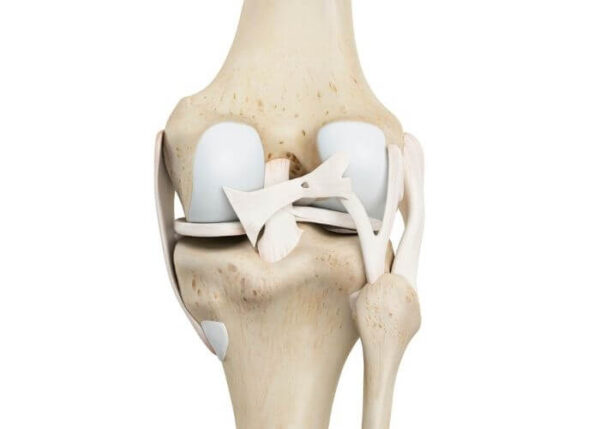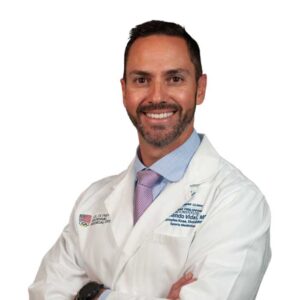What are Knee Ligaments?
Knee Ligaments are bands of tough, elastic connective tissue that surround a joint. Ligaments connect the bones in the body, giving support to a joint and limiting the joint’s movement.
If a knee ligament is damaged, the knee joint may become unstable. Often, ligament damage happens from a sports injury, trauma or from a fall and can cause severe pain. Torn ligaments can severely limit normal knee movement, making it difficult to turn, pivot or twist the leg. Patients in Vail, Aspen and the surrounding Denver, Colorado communities can see Armando Vidal, MD, complex knee surgeon, for the best and most innovative knee ligament treatment.

How many ligaments are there in the knee?
The knee is made up of many ligaments that allow the femur, tibia and patella to all function synergistically. They act like strong ropes in the knee and are responsible for the physiologic motion of the joint.
The main knee ligaments are:
- Anterior Cruciate Ligament (ACL) – forms ½ of an “X” with the PCL ligament, traveling from the front of the tibia to the back of the femur.
- Posterior Cruciate Ligament (PCL) forms the other ½ of an “X” with the ACL, travels from the back of the tibia to the front of the femur.
- Medial Collateral Ligament (MCL) travels down the inside of the knee.
- Fibular Collateral Ligament (FCL or LCL) travels down the outside of the knee.
- Posterolateral Corner – Complex of small structures on the outside, back part of the knee that help control rotation.
- Medial Patellofemoral Ligament (MPFL) – Thick structure on the inner part of the knee cap that keep the knee cap from dislocating.
What are the symptoms of a torn ligament?
For many patients the symptoms of a torn knee ligament can be sudden and painful. Symptoms include:
- A loud pop or popping sensation in the knee
- Sudden and severe pain
- Rapid swelling of the knee joint
- Instability, feeling of the knee sliding out of joint
- Inability to bend the knee completely
What can be done for a torn knee ligament?
Treatment for ligament injuries depends on the severity of the injury and which ligament(s) is torn. Some ligaments have great healing potential (MCL, PCL) while others do not (ACL, FCL). The severity of the injury will dictate how it is best managed. For patients in Vail, Aspen and the surrounding Denver, Colorado communities, careful care should be taken to correctly assess the knee injury. In some cases, especially those with multiple and complete ligament tears, surgery and ligament reconstruction must be performed. Dr. Vidal and his team of specialists can perform a multiple ligament reconstruction in one setting, allowing patients to return to their normal active lifestyles.
How long does it take to recover after ligament reconstruction?
Dr. Vidal has assembled a skilled surgical team who specializes in the treatment of knee ligament injuries and can help their patients recover more quickly. The specific type of ligament tear and subsequent reconstruction plays a major role in recovery time and can vary. Dr. Vidal and his team will walk you through the expected time frame for complete recovery.
Knee Ligament Surgeon
Are you an athlete participating in high-impact sports, or activities that involve frequent twisting, squatting, or bending? If so, you may be at an increased risk of sustaining a knee ligament injury. Injuries to the ligaments often result in a sudden popping noise and immediate sharp pain in the knee. Complex knee surgeon, Doctor Armando Vidal provides diagnosis as well as surgical treatment for patients in Vail, Aspen, and the surrounding Denver, Colorado communities who have experienced an injury to the knee. Contact Dr. Vidal’s team today!

Locations
180 S Frontage Rd W
Vail, CO 81657
226 Lusher Court
Ste 101
Frisco, CO 80443
322 Beard Creek Road
Edwards, CO 81632


